
Treating Founder (Chronic Laminitis) without Horseshoes--Section 23
(full-sized photo version)
Barefoot Event Horses:
They don't just do it, they do it better!

Royal Code and Tyler DeRoo negotiating the Preliminary water complex897opj
-- barefoot -- at Otter Creek Horse Trials in Wheeler, WI, September 14-15, 2002.
(Maximum Prelim dimensions are 6' 11" spread at the base, 4' '7"
spread at highest point and 3' 7" high. Photo by XpressFoto.com)
|
Introduction: Many people think that barefoot may be OK for rehabbing a lame horse, but they still feel that once you get enough recovery to start working the horse again, especially in demanding show disciplines...that of course, you will have to shoe again! Kendall Victorine DeRoo, and her son, Tyler, of Bristol, Wisconsin, have discovered that they can compete in their combined training events better barefoot, however. Their huge collection of old horseshoes is gathering rust in the barn now. While most of their competitors are fussing with screwing in studs into their horses' shoes for more traction, the DeRoos' horses are enjoying more surefootedness than when they were shod. And the DeRoos no longer worry about shoes coming off in competition, and the damage that goes with it. Email Kendall for more information. Kendall tells the story, below: |
Gretchen asked me to develop a section of her laminitis web site, which would focus on my experience with barefoot performance horses. My particular disciplines are dressage, eventing and foxhunting. I have experimented with a Strasser-style trim on 7 horses, primarily Thoroughbreds. My experience relates primarily to horses which were not experiencing serious or chronic lamenesses, but were sound horses with the occasional soft tissue injury, stone bruise, etc. These are things considered common to horses in work, but which I now regard as largely unnecessary.?
My horses have been in this trim less than a year, but I had always believed in the natural lifestyle that Strasser recommends. Like most people, I accepted the commonly-held beliefs that stabling, bandaging, blanketing, clipping, and -- of course -- shoeing, were "what you did" for horses who were actively training and competing. But I also believed that horses needed lots of freedom of movement with other horses, could withstand weather extremes, and that movement seemed to fix just about anything that ailed them. I usually pulled the shoes for winter and, when I couldn't afford to put 4 shoes on, I discovered that the horses did quite nicely being barefoot behind. So it wasn't hard for me to go the rest of the way, pull the front shoes, and begin the Strasser style trim. (I am using the term, "Strasser-style" trim because I feel that my horses have not yet achieved a true "Strasser" trim.)
Most of my horses have been Thoroughbreds off the race track, and have presented me with various physical, mental or emotional "issues." Royal Code (see photos), for example, is a very well-bred Thoroughbred who bowed a tendon at Arlington Park as a 3 year old and was deemed useless. The horses have taught me that time, patience and turnout solve problems. In the past year, they have taught me that a barefoot Strasser style trim solves problems faster and prevents others.
The following case studies describe two of our horses. One, Uncomplicated, progressed slowly, while the second, Royal Code, had a relatively easy transition to barefoot.
Case 1: "Uncomplicated"
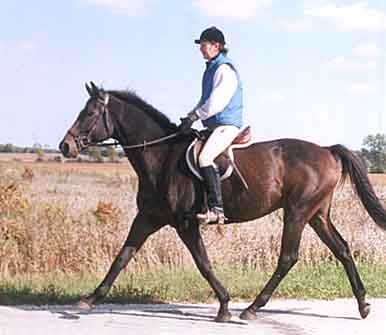
Uncomplicated, ridden by Kendall DeRoo, trotting on a blacktop road.
(Photo, Gretchen Fathauer)
Six months before this picture was taken, this horse was diagnosed with thin soles, early ringbone, and possible sidebone--with a veterinary recommendation to inject the coffin joint and put on shoes and pads. Instead of that, he remained barefoot and was trimmed according to Strasser guidelines.
We were able to ride him on a daily basis throughout the transition, but we had to alter our agenda, which proved extremely frustrating at times. My son, Tyler, had planned to event him throughout the summer, but the horse had other plans.
Once we began the transition, we stuck with it and ultimately let the horse tell us what he could or couldn't do on a daily basis. Some days, he felt lame in 2 or 3 feet; some days, he was lame on grass but sound on pavement; some days he would drop out of the canter without warning; some days, he started out "off," but worked out of it. And some days, he was sound. We gave up trying to stay on a training or conditioning program, but continued to ride every day for at least 30 minutes, in spite of lameness. Interestingly, the lameness never got worse with work, but often improved, which reinforced the Strasser concept that daily exercise and hoof mechanism was critical to transition and recovery.
Surprisingly, sand turned out to be the worst footing to work on during the transition to barefoot. Sand does not provide enough resistance to promote hoof mechanism and it rolls so much that it creates uneven pressure on sensitive (changing) parts of the hoof. Conversely, we discovered that walk and trot work on road pavement, introduced gradually, was an excellent way to improve hoof mechanism. I emphasize that everything we did was introduced gradually, done in moderation and carefully monitored for results.
There were also periods of 2-3 weeks when his trot work was sound, but his canter felt like the wheels had fallen off. So, we didn't canter, but worked in trot, instead. I realized that this was the horse's feet telling me that there were changes going on, either something was "brewing" (an abscess developing) or something had just changed in response to trim work I had recently done. Then, one day, I asked for the canter, got a clean depart and a soft, balanced 3-beat canter.
Below: Uncomplicated's feet after a long trot on blacktop...
so much for Thoroughbreds allegedly having flat feet!
(Photos, Gretchen Fathauer)
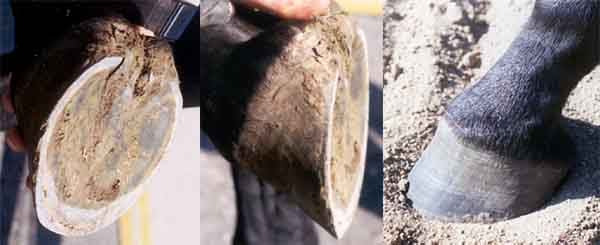
Uncomplicated, fores.
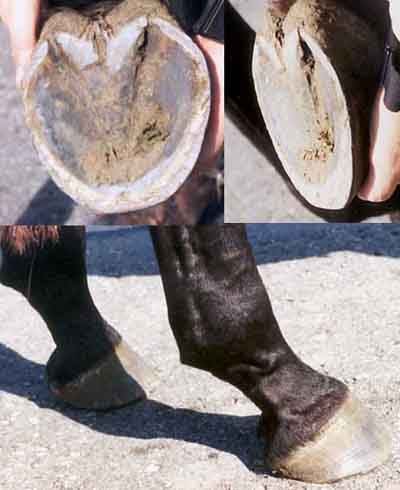
Uncomplicated, hinds.
As of November, 2002, Uncomplicated is in regular work, and in fact, just foxhunted barefoot. Hunting was an excellent test of his bare feet--galloping through mud, fallen leaves, snow, ice on streams, gravel, corn stubble, macadam, frozen ground, crusty ploughed ground, slippery grass--and he was wonderful.
He has a different, better balance in the bridle, and he "corners" much better on sharp turns in deep woods. He used to bank those turns, to the point where you felt you had to weight the outside stirrup and keep your weight well back to avoid a slip/fall. Now, he bends! Fantastic!
Case 2: "Royal Code"
Royal Code is a 10 year old Thoroughbred gelding whose shoes were pulled in February, 2002. He was started in the Strasser-style trim in May, at roughly the same time that my son began eventing him. They completed 2 Novice events, then 4 Training Level events, where they finished 7th, 6th, 4th and lst, all with clean cross-country trips. In September, they moved up to Preliminary Level and completed 2 more events. In their first Preliminary event at Kentucky Classic, they finished 14th out of 28 starters, while 10 horses were eliminated on cross-country.
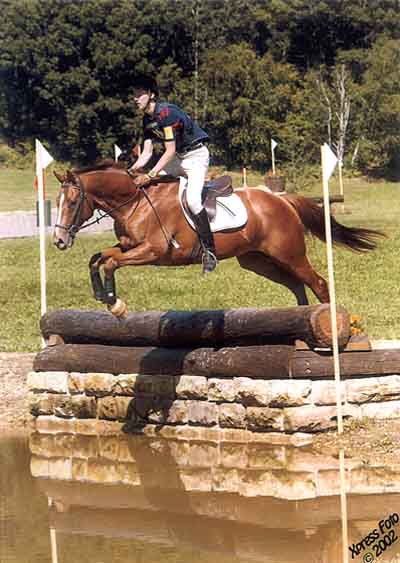
Royal clearly has no doubt that his bare feet will be perfectly comfortable
on take-off and landing, regardless of terrain. (Photo by XpressFoto.com)
Royal's transition to barefoot was relatively easy, and despite doing conservative trims because he was competing, his feet continued to change. Competition became an excellent way to measure the benefits of a horse going barefoot. The intense environment of competition highlighted all the improvements I saw in the horse at home:
|
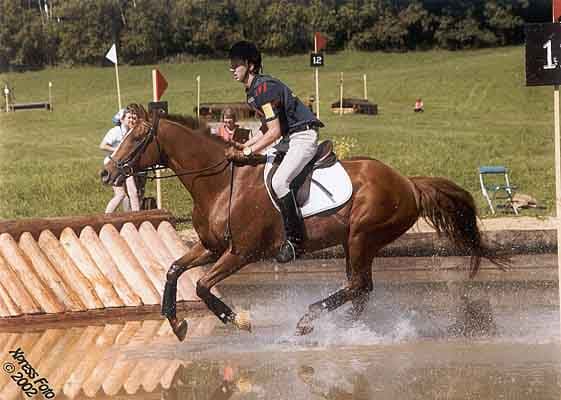
Everything about these photos reflects a horse who is enjoying his job. Royal's expression
shows confidence and enthusiasm, while his balance and carriage on a soft rein
allow him to make athletic efforts with ease. (Photo by XpressFoto.com)
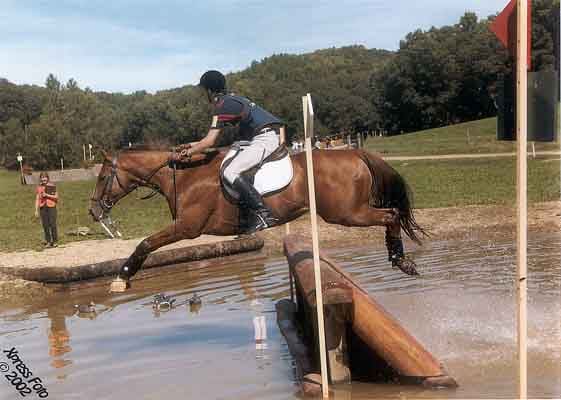
(Photo by XpressFoto.com)
I'm convinced that the reason for these improvements is found "where the rubber meets the road". Royal's feet, in the Strasser-style trim, are performing their intended role as auxiliary pumps to the heart?. This allows his circulatory system to function at optimum capacity and results in a system which carries more oxygen throughout the horse's whole body. This "oxygenation" of the horse's entire body is, I think, the same thing that dressage riders recognize when they comment that a dressage horse, properly warmed up and relaxed, seems to "grow" in stature and carriage during the course of a good training session.
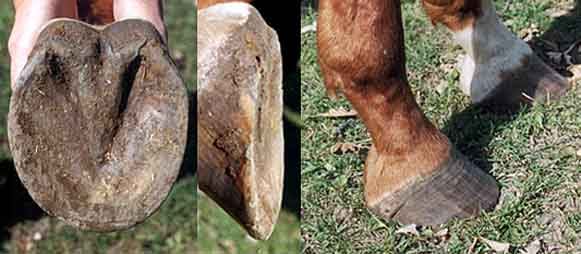
Royal Code, fores. (Photos, Gretchen Fathauer)
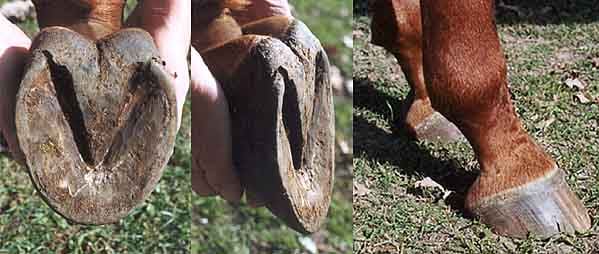
Royal Code, hinds. Although Thoroughbreds are reputed to have thin walls
and flat soles, both of these ex-racehorses have developed thick walls
and good concavity. (photos, Gretchen Fathauer)
Traction: "Look, Ma, no studs!"
Since our horses have been in the Strasser-style trim, their traction has been exceptional. Stumbling, while never a major problem for any of them, has virtually disappeared. And while I believe that all horses--barefoot or shod with flat shoes, borium, caulks or studs--can slip in wet or muddy conditions, I think barefoot horses slip "differently." (I'm referring here to slipping of the hindquarters.) A barefoot horse has more control because he can feel what's happening: a bare foot slips only until it comes under the horse's center of balance, so that the horse maintains control of the slip. A smooth shoe, once it slips, continues to slide beyond the natural grab a bare foot would exert from suction and skid-brake effects. Caulks, studs or borium can certainly stop a slide, but it is the metal doing it, not the horse's foot, so the shoe is in control of the horse. I think this causes unseen torquing, twisting and stretching -- "minor" damage which gradually accumulates to become chronic stocking up, windpuffs, joint problems, etc.?
I also question the value of studs for jumping because I suspect they affect the horse's proprioception relative to measuring the effort needed to clear a jump. I began to wonder about it at an event where stadium jumping was held in a grass field after a day of heavy rain. Horse after horse had 3 or 4 rails down on a straightforward training level course. These were horses who obviously knew how to jump and were ridden by competent riders--nothing frantic or scary about their rounds, just a lot of rails down. And stadium was held before cross-country, so that was not a factor. Royal, jumping barefoot, was one of only two horses out of 20 to jump clean.
I think studs may do their job too well; they hold the horse's foot on the ground a fraction longer than the horse expects, and alter his effort (thrust/ balance/trajectory) just enough to drop a rail. Not to mention the major hassle of fussing with the studs, screwing them in, unscrewing them, losing them, and who even knows how big or small a stud to use? Bare feet, on the other hand, will never give a horse too much traction.4
Another benefit of bare feet is the ability to custom tailor the feet to competition conditions. If, for example, there are slippery conditions, you can adjust the trim to gain optimum traction.5
As to why Royal Code is wearing bell boots in these photos: the first time Royal went Prelim, he grabbed himself on the right front and got an overreach. Fortunately, it was low enough that it was more of an abrasion than a true cut, but the bell boots were a precaution against further damage. I specifically asked Martha Olivo about it in October. She looked at his feet and said that his hind toes were still too long and we would have to continue to adjust the trim as his balance changed. She recommended that we continue to use the bell boots until we were sure there would be no problem. So it's really another transition thing. Frankly, I can't wait to get rid of them. I hate bell boots.
* * * * * * * * * *
My horses are only partially through their transition to barefoot and I am feeling my way through the process, learning by doing. As long as I continue to see improvements, I see no reason to put shoes back on. Barefoot is working for my horses in my disciplines, and I wholeheartedly recommend it to anyone who is thinking "beyond the horseshoe" and wants to give it a try.
Tyler is trying out for a spot on the Area IV team, which is to compete at the North American Young Riders Championships in Quebec in August, 2003.
If anyone wants encouragement, you can email me. Good luck, and happy riding! --Kendall Victorine DeRoo
_________________
?Strasser, Hiltrud. Shoeing: A Necessary Evil? Pp. 52, 64
Strasser, Hiltrud. The Hoofcare Specialist's Handbook, P. XI-15
2Strasser, Hiltrud. Shoeing: A Necessary Evil? P. 52
Strasser, Hiltrud. The Hoofcare Specialist's Handbook, Pp.III-16, IV-39-43.
3Strasser, Hiltrud. Shoeing: A Necessary Evil? Pp. 62-64.
4Strasser, Hiltrud. Shoeing: A Necessary Evil? P. 63.
5Strasser, Hiltrud. The Hoofcare Specialist's Handbook, Pp. V-13-17.
Update--
Royal Code and my son Tyler WON their division of the Preliminary Level at the Fox River Valley Pony Club Horse Trials, Barrington, IL this past weekend (June 21-22, 2003), with a final score of 39.5 penalty points! FIRST PLACE!!! BAREFOOT!!! YAY!!!
After placing 4th in dressage, Royal jumped clean cross-country, galloping blithely over a course which caused 4 falls, numerous refusals and tons of time penalties. Only one other horse in the division had no jump or time faults. Of 56 total starters at the Preliminary level, Royal had the third fastest time of the day, finishing 11 seconds under the time, and moving into first place. You can't tell me shoes, and particularly studs, don't slow a horse down.
Stadium jumping, the third phase of the event, was run in reverse order of placing, which meant Tyler jumped last and had plenty of time to work up a good case of nerves. They had one rail down, but so did the second place horse, so the standings didn't change and THEY WON! (Am I excited, or what?)
They are now qualified for the the DeBroke Championship in September, Area IV Preliminary Championships in October and are hoping to be selected for the Area IV Young Rider One Star team competing in Canada in August.
Much credit for Royal's success goes to Erika Czinki, his Hoof Groom. (Erika may be reached at 630-730-2088 or comgabrielle@AOL.com) I think Royal's story is proof that barefoot horses are happy horses, capable of major performance accomplishments, perhaps more than we even know.
Update II--
Overall this year (2003), they entered 8 Preliminary events, placing in 6 of those--all with clean cross-country rounds--including first place at Fox River Valley Horse Trials. Despite the fact that Tyler and Royal presented the best competitive record and were the first choice of the selectors at the North American Young Riders Championships, the selectors would only place them on the team if we would put shoes on the horse--which we did not agree to do. It was an enormous disappointment, but seeing the health, soundness, 'bloom,' recovery, athleticism, vitality and general 'robustness' of barefoot horses, I would never go back to shoes.
They moved up to competing at the Intermediate level at the River Glen Horse Trials in November, 2003.
Later photos...
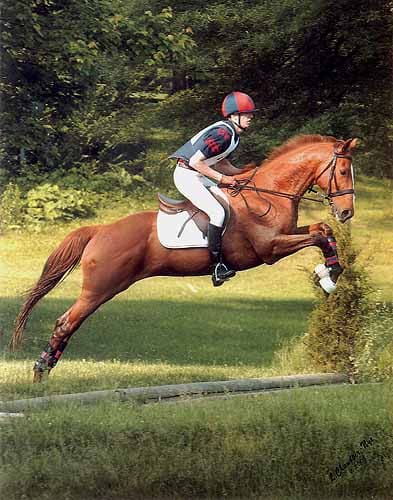
Mayfest, Lexington, KY, May, 2003, Training Level (Xpress Foto)
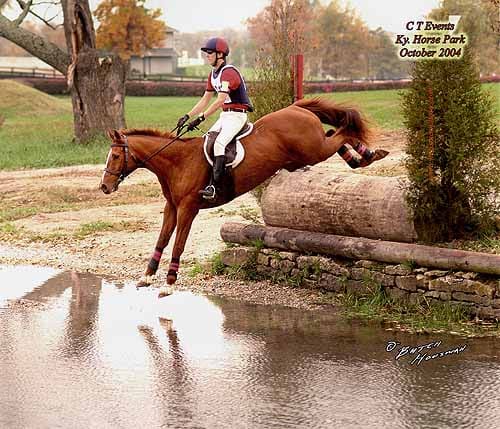
Midsouth Horse Trials, Lexington, KY, Oct. 2004, Preliminary level (Butch Housman photo)
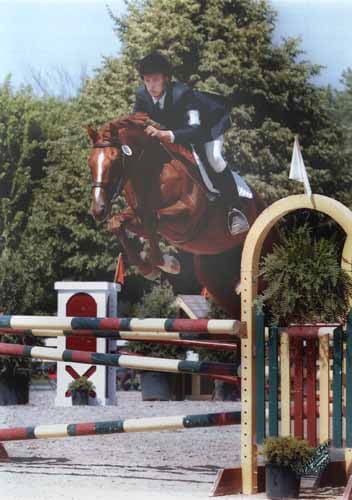
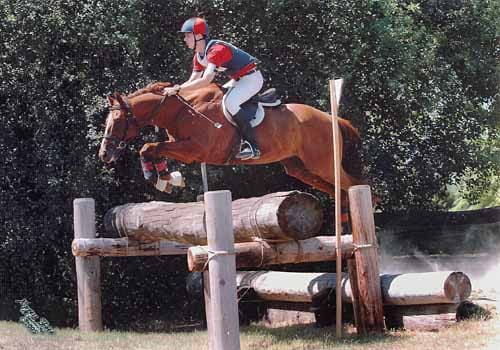
Maui Jim Horse Trials, Wayne, IL, July 2005, Intermediate level (Xpress Foto)
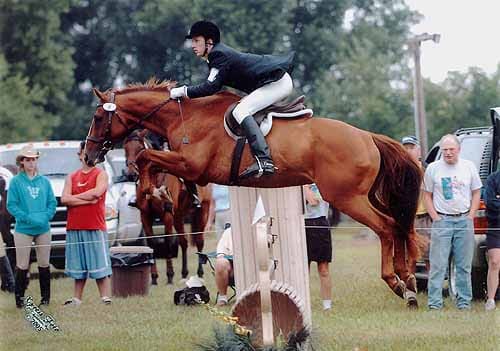
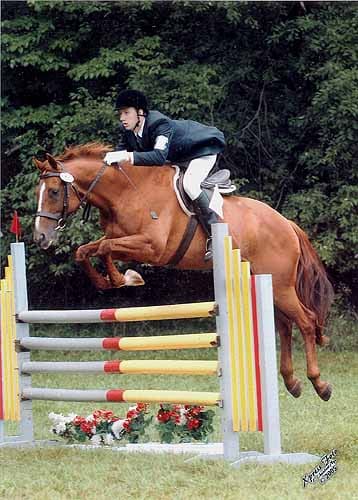
Hunters Run, Metamara, MI, Aug. 2005, Intermediate level (Xpress Foto)

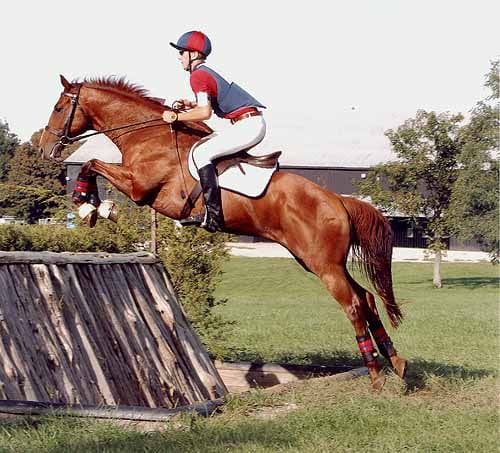
Kentucky Classic, Lexington, KY, September 2005, Intermediate level (Xpress Foto)
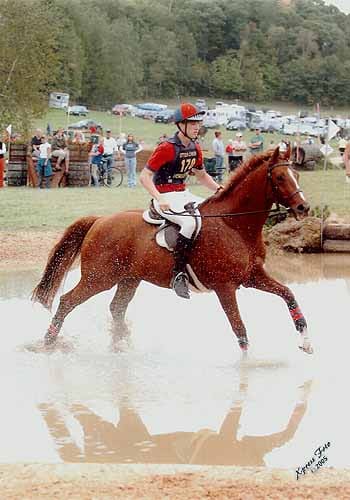
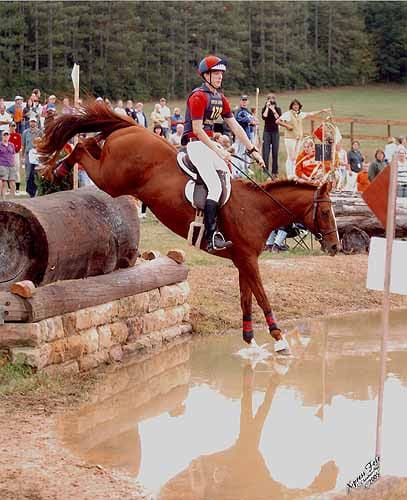
Otter Creek Fall Horse Trials, Wheeler, WI, September 2005, Intermediate level (Xpress Foto)

Otter Creek Fall Horse Trials, Wheeler, WI, September 2005, Intermediate level (Xpress Foto)
Update, April, 2006
Gretchen asked me to update this section and it?s unquestionably overdue (!) and there?s quite a bit of news. Tyler is now at the University of Minnesota majoring in Aerospace Engineering and working 20 hours a week to defray school costs, which makes it a bit tricky to get to Intermediate events. The horses have been in a barefoot trim for four years now, and they continue to teach us new things about their feet.


Maui Jim Horse Wayne Horse Trials, Wayne, IL, July 2005, Open Intermediate (Xpress Foto)
Kentucky Classic Horse Trials, Lexington, KY, September 2005, Open Intermediate (Xpress Foto)
Competition News Update
In 2003, competing barefoot, Royal Code proved himself to be a solid Preliminary level event horse. He completed 7 Preliminary events, 5 of them with clean cross-country rounds, and moved up and completed one Intermediate event at the end of the season, finishing 5th. In late winter of 2004, Royal came in from pasture on three legs, unable to put any weight on his right hind leg. In a few hours the leg swelled dramatically. The vet who made the emergency call misdiagnosed the situation as a broken femur (thigh bone), but in fact it turned out to be lymphangitis. Because of the misdiagnosis, antibiotics weren't administered until over a week after onset, and Royal had to do the initial healing on his own. The cause is still a mystery, although I suspect an insect bite, possibly from a spider. Royal recovered, but the timing was terrible for the competition season. He only got to 3 events, 2 at Preliminary level, and 1 at Intermediate.


Maui Jim Horse Wayne Horse Trials, Wayne, IL, July 2005, Open Intermediate (Xpress Foto)
Hunters Run Horse Trials, Metamora, MI, Aug. 2005, Open Intermediate (Xpress Foto)
In 2005, Royal ran 2 early Preliminary events, both clean, and moved up to Intermediate in July at the Maui Jim Wayne Horse Trials, where he finished third. This event is known for setting a very tough stadium course, and this one was no exception. The course is set to maximum dimensions, and, in talking to one of the officials, I found out that the only difference between the course for Advanced and Intermediate levels was that two fences had been lowered ?a tick.? And it proved difficult for the Intermediate horses: of 15 horses, no one went clean; one horse had two rails down. Royal and another horse had the next best score with 3 rails and everyone else had more than 3.
Tyler and Royal completed four more Intermediate events: at Wayne in August where they finished 8th, Hunters Run (6th), Kentucky Classic (6th) and Otter Creek (5th). In the USEA Area IV year-end awards, Tyler was 6th in the Top Ten Intermediate Riders and Royal Code was 10th in the Top Ten Intermediate Horses.

Otter Creek Fall Horse Trial, Wheeler, WI, September 2005, Open Intermediate (Xpress Foto)
Dimensions of jumps
Photographs can be deceiving. Some people who have seen the earlier website photos in this section of Tyler and Royal competing at the Preliminary level have commented, ?Well, he may be barefoot, but he?s only jumping those little logs.? Most of the photographs in this update are from Intermediate competitions. The dimensions of obstacles at the Intermediate level are specified by the U. S. Equestrian Federation, as follows:
|
Maximum height of fixed obstacles: 3? 9? |
Four Years of Barefoot: What the Feet Look Like
In our horse population, two horses are retired, but the others are in regular work. All the horses are sound and their feet have stabilized. At the same time, they continue to improve. Hoof walls have thickened and sole horn quality and concavity have improved. The feet don?t chip, split or crack. Walls and soles show healthy pigment. The feet have developed a natural 'horseshoe' (a rim around the edge of the sole) and a tough toe callous. Front feet are big and round and open; hind feet are big and spade-shaped and open. The width of the heels is about 25% of the circumference of the hoof. Viewed from the bottom (solar view), the bulbs are a smooth continuation of the heels. On palpation, digital cushions are firmer. Frogs are tough, but elastic, and adapt to environmental conditions: they callous in winter as protection against the frozen ground and in summer as protection against hard, dry ground; in spring or wet conditions, they soften or shed.
Of the working horses, Royal Code is actively competing in eventing at the Intermediate level. Uncomplicated is a foxhunter, jumper and cross country horse: an all-around riding horse. Acrobat, with the slightly clubby left front, continues to improve (he has never been unsound; we are just trying to correct hoof form), while his right front has achieved nice concavity. He will begin competing in dressage and combined training this year.

Hunters Run Horse Trials, Metamora, MI, August, 2005, Open Intermediate (Xpress Foto)
Hoof Form and Mechanism
Good hoof form is a ground parallel coffin bone suspended in the hoof capsule by a tight laminar connection which facilitates concavity; low, wide, open heels; a solid frog and a round shape to the front feet and a spade shape to the hind feet.
Once good form is achieved, it produces an even growth pattern. Proper form establishes proper balance, which stimulates proper growth, which generates stronger tissue, which allows the horse to move correctly, which promotes proper form, which continues this positive cycle. Growth lines on the wall are tight and evenly spaced and soles grow evenly at both the toe and the heel. Imbalances such as flares are less likely to occur oncegood hoof form is established .
It?s impossible to isolate ?barefoot? from other factors in the horse?s life: turnout, exercise, training, saddle fit, diet, footing, etc. The biggest key to barefoot success is the ability of the horse to move, a combination of turnout (as much as possible) and ridden exercise. A proper trim which establishes and maintains good hoof form and mechanism allows optimal circulation to the hoof, through the hoof, out of the hoof, up the leg and throughout the body. A healthy circulatory system is the baseline for health: it delivers nutrition effectively, flushes toxins, creates a healthy immune system and produces the ?bloom? that we all admire when we see it.
The feet are critical to circulation in the horse?s entire system, the corium in each hoof acting as an auxiliary pump with every step, to assist the heart. When I look at a horse, the sheer size of the animal tells me that there would be an inordinate amount of strain on the heart if that organ was the sole pump responsible for providing adequate circulation throughout the mass of the horse?s body and length of his legs. An auxiliary system at the end of each leg -- the hoof ? to aid in recirculation makes absolute engineering sense.
I?ve heard and read that horses can?t go barefoot because they will wear down their feet, that hoof growth can?t keep pace with wear. I have never seen anything remotely like that in our horses. In terms of survival, it only makes sense that nature would provide a balance between hoof growth and wear. But that balance can only be maintained in a bare hoof if it has correct hoof form and mechanism. Blood is the medium by which nutrients are delivered to the cells: a healthy circulatory system delivers nutrients evenly throughout the tissues. Anywhere the circulatory ?hose? is pinched (e.g., the circumflex artery in a frontally loaded hoof), then on a cellular level, nutrients are either not delivered to the cells or delivered in an uneven manner. If the cells don?t receive balanced nutrition, they can?t produce balanced growth.

Kentucky Classic Horse Trials, Lexington, KY, September 2005, Open Intermediate (Xpress Foto)
Maintenance
Our horses will never be able to self-maintain their feet on our relatively soft footing, but there is much less maintenance now than there was when we began. I emphasize that our horses did not have pathological feet when we began this barefoot trim. They came into the trim as sound, working horses who were turned out as much as possible. The length and difficulty of the transition varied from horse to horse (see original part of this section), but the benefits have been remarkable.
We correct things as we see them, checking the hoof daily. Our trimmer comes regularly, but we adjust the interval according to the horses and the conditions. During the transition, the feet were trimmed every two to three weeks and I trimmed in between our trimmer?s visits. Now that the feet are stabilized, they are trimmed every 4 weeks during the competition season, every 5 weeks during the winter and ?tweaked? as necessary in between.
We trim the heels, excess bar and any bar material that sneaks onto the sole. We exfoliate sole tissue primarily with the back of the hoof knife and it?s amazing how much old, dead sole releases and how much concavity is exposed just by removing sole that?s ready to slough. By monitoring growth on a daily basis, we can address wall growth and any flaring by rasping from the top. We shorten heels from the bottom, but rarely have to trim wall length from the bottom. I think this is crucial to successful barefoot trims: rasping from the top to maintain hoof shape rather than reducing toe length from the bottom. Our horses? hooves are maintained often enough that we don?t need to use nippers.
Traction and Traction Devices


Otter Creek Fall Horse Trial, Wheeler, WI, September 2005, Open Intermediate (Xpress Foto)
Traction is a fascinating subject. I still firmly believe that any horse can slip--barefoot, shod, shod with borium, shod with studs, mounted, unmounted, wild, domesticated--it?s bound to happen. But a healthy bare foot comes equipped with a number of interacting traction devices. The hoof is a three-dimensional structure incorporating multiple geometric shapes (cones, domes, triangles, arches), each with its own properties of strength and flexibility. It has a complex hydraulic system of blood flow integrated into a number of anatomical parts (frog, sole corium, lamina, lateral cartilages, etc), each composed of a different material with unique properties for shock absorption and energy dissipation. It is the foundation for a column of bones and joints aligned in a slightly offset position and leaf-spring arrangement. The interaction of these structures allows the horse to absorb and dissipate shock waves, but it depends on a healthy hoof to do it.
I had a light-bulb moment last summer while riding in our sand arena. Tyler had ridden Royal in the arena a couple of days before, after a rain while the sand was still wet, and left a number of hoof prints which baked into perfect molds of the foot. I didn?t ride over them or drag that corner of the arena, but studied them from both my human vantage point and from horseback.
What I saw was a vivid illustration of how the hoof functions: because the surface was wet (not just damp), some of the hoofprints showed a slide of up to about 3 inches. The impression showed the heels expanding to the width of the widest part of the hoof, a graphic demonstration of heel expansion upon weightbearing. This expansion substantially increased the surface area of the back of the foot when it made direct contact with the ground. What I found most interesting, though, was the impression of the heel area and how the ?W? pattern of the back of the foot (heels, bars and frog) expanded much like a lattice. The sand mold clearly showed a series of alternating raised and indented grooves across the entire back edge of the hoof: outside hoof wall (indented), bar-heel triangle (raised), bar (indented), collateral groove (raised), outside half of frog (indented), sulcus (raised) and then the series repeating on the inside half of the hoof...producing eleven grooves which resembled nothing so much as the tread on a tire!
In contrast are tracks I?ve seen from horses shod with pads, which, in soft footing, show nothing but slide until the toe finally digs into the surface to produce breakover. The pad prevents any traction effect from the back of the foot: the heels can?t expand to grip the ground, the smooth, slick pad renders useless the natural braking effect of the back of the hoof and the frog can?t feel or contact the ground.
Adding studs undeniably gives braking power. Studs were designed for one purpose: to stop. They are a simple mechanical addition to the shoe and they do exactly what they were intended to do: they stop forward motion. My question is: at what price? Studs have become increasingly popular. Originally they were used by upper-level competitors only for extreme cross country conditions, and only on the hind feet. Now they are used for lower level dressage tests ridden on sand or grass in perfect weather conditions, and by Beginner Novice riders jumping 2? cross country fences, and on all four feet. Somehow studs have morphed into a safety device.
Studs reduce the amount of slide, although researchers in biomechanics feel that the foot needs some slide in order to withstand impact and dissipate shock. Studs change the natural sequence of hoof impact: they dig in the heel upon ground contact, altering the way impact is absorbed and energy is dissipated. By comparison with a bare hoof, which can dissipate shock over virtually the entire surface area of the foot, and spread the impact over multiple structures (sole, frog, digital cushion, lateral cartilages), studs transmit the concussion of impact the foot the leg, forcing each joint to accept more shock than it was intended to take. Dr. Jeff Thomason, hoof researcher at the Ontario Veterinary College, discussed this subject in a lecture at the recent AFA International Hoof Care Summit:: "there's a little bit of slide necessary, but not too much, because if you get too much you can strain the muscles higher up the leg -- too little and you jam that foot into the ground and you start getting bone and joint problems." ?

Midsouth Horse Trials, Lexington, KY, October, 2004, Preliminary level (Butch Housman photo)
There is very little (any?) science behind what kind or how many studs to use in a given situation. Riders use multiple studs of varying lengths on the same shoe. This certainly gives more braking power, but it also prevents the foot from twisting or rotating on landing if it needs to, for example when making a turn or if a horse has to make an extraordinary effort to save himself in a sticky situation. Any torque produced in this situation has nowhere to go but up the leg, to be absorbed by the joints, ligaments, tendons and soft tissue. Dr. Thomason also addressed this issue:: ?designs of shoes [and traction devices] often have one function in mind . . . to give good traction . . . without any testing of what does it do to the horse . . . you?ve got to then follow up and say ?what kind of injuries do we get with these shoes? and then evaluate which is good or not and those kinds of follow-up tests are rarely done by the people making the shoes. Their objective . . . is to make something that will do the job you?re asking of it . . . giving traction to the shoe but they then don?t go on to say, how many injuries is it going to cause?'??
_________________
? "The Science of Biomechanics vs. the Art of Farriery", Dr. Jeff Thomason, Hoof Researcher, Ontario Veterinary College, Guelph, Ontario, Canada, lecture delivered at American Farriers Association International Hoof Care Summit, Cincinnati, OH, Jan. 31 - Feb 3, 2006.
2 Ibid.
Environmental Influences on Bare Feet
Given the geography of this country, most riding horses are living on something other than ideal footing, and as owners, we have to observe our horses, study the adaptations they present and then trim as necessary.
Barefoot horses are most successful when they are kept as naturally as possible. Our horses are turned out all year round, and we live in Wisconsin, not known for its balmy winters. Shelter, water and hay or pasture are always available. We will blanket occasionally for extreme cold or wet conditions, but we don?t body clip and we allow down time after the competition season. The horses unquestionably look scruffy during the winter, but we live with it, and they produce magnificent healthy coats in the spring.
Last year's exceptionally dry summer provided a real learning experience. We had weeks of no rain and as the terrain got hard and dry, so did the feet. Vegetation growth slowed way down; so did hoof growth. But mechanism didn't suffer: the horses' feet absorbed concussion with no ill effects. Without shoes, there were no nails to loosen up, no chipping, no compression rings. At competitions, some riders withdrew their horses before cross-country, to save their legs. And for horses which were shod, that was a good idea. I studied the hooves of the horses competing at that event and I saw a lot of loose shoes, missing nails, enlarged nail holes and wavy compression rings. I can only imagine the feeling the horses get, of from the vibrations of the metal shoe, exacerbated by the loose nails, all of which creates imbalance in all phases of the stride. Rather like running in jogging shoes without lacing them up: the shoe hits the ground before your foot does, so you feel an extra/shadow vibration.
The Marvel that is the Hoof
The horse's hoof is an awesome and complex marvel of design, function and engineering. It is a fascinating thing to study and observe and, at this point, poses more questions than we have answers for. With the groundswell of interest in the subject of bare feet -- largely due to the Internet -- and with the combined efforts of researchers, trimmers, farriers, veterinarians, riders, trainers and above all, horse owners, we have no idea where this can lead. But one thing remains constant: in the end, it's all about the horse.
For more information on competing barefoot, Click HERE
Back to home page--Table of Contents
Article in sections with "thumbnail" photos for
fastestdownloads:
1 9 17
2 10 18
3 11 19
4 12 20
5 13 21
6 14 22
7 15 23
8 16 24
NAVICULARArticle in sections with full-sized photos for print-outs:
1 9 17
2 10 18
3 11 19
4 12 20
5 13 21
6 14 22
7 15 23
8 16 24
NAVICULARTo Strasser case studies--thumbnail photos for
fasterdownloads
To Strasser case studies--large photosPlease sign my guest book! Photos of my pets My farm
Share Barefoot success stories on this page
Buy or sell used HORSE BOOTS Natural board Barn Listings
Click here to subscribe to naturalhorsetrim
(I moderate this listserv to weed out "fluff.")Send Email to Gretchen Fathauer, or call (740) 674-4492
Copyright by Gretchen Fathauer, 2015. All rights reserved.